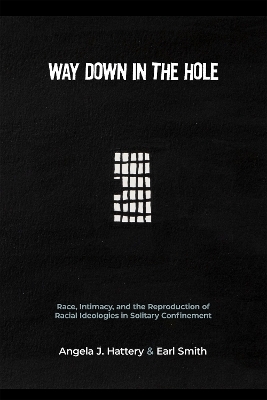
Way Down in the Hole
Rutgers University Press (Verlag)
978-1-9788-2378-5 (ISBN)
Based on ethnographic observations and interviews with prisoners, correctional officers, and civilian staff conducted in solitary confinement units, Way Down in the Hole explores the myriad ways in which daily, intimate interactions between those locked up twenty-four hours a day and the correctional officers charged with their care, custody, and control produce and reproduce hegemonic racial ideologies. Smith and Hattery explore the outcome of building prisons in rural, economically depressed communities, staffing them with white people who live in and around these communities, filling them with Black and brown bodies from urban areas and then designing the structure of solitary confinement units such that the most private, intimate daily bodily functions take place in very public ways. Under these conditions, it shouldn’t be surprising, but is rarely considered, that such daily interactions produce and reproduce white racial resentment among many correctional officers and fuel the racialized tensions that prisoners often describe as the worst forms of dehumanization. Way Down in the Hole concludes with recommendations for reducing the use of solitary confinement, reforming its use in a limited context, and most importantly, creating an environment in which prisoners and staff co-exist in ways that recognize their individual humanity and reduce rather than reproduce racial antagonisms and racial resentment.
Way Down the Hole Video 1 (https://youtu.be/UuAB63fhge0)
Way Down the Hole Video 2 (https://youtu.be/TwEuw1cTrcQ)
Way Down the Hole Video 3 (https://youtu.be/bOcBv_UnHIs)
Way Down the Hole Video 4 (https://youtu.be/cx_l1S8D77c)
ANGELA J. HATTERY is a professor of women and gender studies and co-director of the Center for the Study and Prevention of Gender-Based Violence at the University of Delaware in Newark. She is the author of eleven books, including Policing Black Bodies: How Black Lives Are Surveilled and How to Work for Change and The Social Dynamics of Family Violence (both with Earl Smith). EARL SMITH is a professor of women and gender studies at the University of Delaware in Newark. He also holds the position of Emeritus Rubin Distinguished Professor of American Ethnic Studies and Sociology at Wake Forest University. He is the author of thirteen books, including Policing Black Bodies: How Black Lives Are Surveilled and How to Work for Change and The Social Dynamics of Family Violence (both with Angela J. Hattery). TERRY A. KUPERS is a psychiatrist and professor emeritus at the Wright Institute in Berkeley, California. He is the author of Solitary: The Inside Story of Supermax Isolation and How We Can Abolish It and Prison Madness: The Mental Health Crisis Behind Bars and What We Must Do About It.
List of Figures
Acknowledgments
Foreword
Introduction
Part 1: The Hole
Chapter 1: A Day in the Hole
Chapter 2: Solitary Confinement in Context
Chapter 3: Ideal types
Part 2: Scholar’s Story
Chapter 4: Recruiting Inmates
Chapter 5: Getting to the hole
Chapter 6: Scholar’s Story
Chapter 7: Racism in Solitary
Chapter 8: The cell assignment
Chapter 9: It’s “culture” not “race’
Part 3: CO Porter and Dr. Emma
Chapter 10: Prison Sitings
Chapter 11: Prison Town--Larrabee
Chapter 12: Dr. Emma and the Professional Staff
Chapter 13: Microtel
Chapter 14 It’s either this or the coal mine
Chapter 15: Sometimes I sleep in my car
Part 4: Fifty’s Story
Chapter 16: Dehumanization
Chapter 17: Language
Chapter 18: Studies with Monkeys
Chapter 19: Choosing the hole
Chapter 20: Hygiene products
Chapter 21: The mirror
Chapter 22: Food
Chapter 23: Time
Chapter 24: Mail
Chapter 25: Extreme violence
Part 5: Marina’s Story
Chapter 26: Welcome to SCI-Women
Chapter 27: The women’s hole
Chapter 28: Meeting the Mass Killer: Solitary confinement is her “home”
Chapter 29: The BMU
Chapter 30: CO Lisa
Chapter 31: Wendi
Chapter 32: Marina
Part 6: CO Travis
Chapter 33: We are Trump’s Forgotten
Chapter 34: Solitary should be “hard” time: this isn’t a daycare!
Chapter 35: Correctional PTSD
Chapter 36: Faking mental illness to get a candy bar
Chapter 37: “Therapy” with Dr. Emma
Chapter 38: Programming
Chapter 39: TVs, Trays and [Flush] Toilets
Chapter 40: The Flipped Script
Chapter 41: The Job of the CO, Work of the CO
Chapter 42: Contact and intimate surveillance
Chapter 43: White racial resentment
Part 7: White Supremacy and the Lies White People Tell Themselves
Chapter 44: The Lie Built on a Foundation of White Supremacy
Chapter 45: Critical Race Theory: The Lie is Confirmed in Solitary Confinement
Chapter 46: Yet Another Lie: To be Black is to be a Criminal
Chapter 47: From Solitary to the Streets
Chapter 48: What about those who “chose” solitary?
Chapter 49: Emancipated Slave and the White Sharecropper
Chapter 50: Dying By Whiteness
Chapter 51: Solitary Confinement: Reducing rather than (Re) Producing White Racial Resentment
Chapter 52: Strangers in their Own Land
Chapter 53: The Lies the COs Tell Themselves
Chapter 54: January 6, 2021---White nationalists storm the US Capitol
Epilogue
Notes
Bibliography
Index
| Erscheinungsdatum | 27.09.2022 |
|---|---|
| Vorwort | Terry A. Kupers |
| Zusatzinfo | 7 b&w images |
| Verlagsort | New Brunswick NJ |
| Sprache | englisch |
| Maße | 156 x 235 mm |
| Gewicht | 426 g |
| Themenwelt | Geschichte ► Teilgebiete der Geschichte ► Kulturgeschichte |
| Recht / Steuern ► Strafrecht ► Kriminologie | |
| Sozialwissenschaften ► Ethnologie | |
| Sozialwissenschaften ► Politik / Verwaltung | |
| Sozialwissenschaften ► Soziologie | |
| ISBN-10 | 1-9788-2378-9 / 1978823789 |
| ISBN-13 | 978-1-9788-2378-5 / 9781978823785 |
| Zustand | Neuware |
| Haben Sie eine Frage zum Produkt? |
aus dem Bereich


